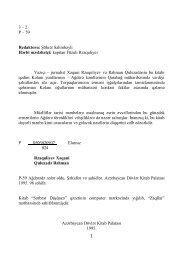ARMENIAN - Erevangala500
ARMENIAN - Erevangala500
ARMENIAN - Erevangala500
Create successful ePaper yourself
Turn your PDF publications into a flip-book with our unique Google optimized e-Paper software.
Following the struggle between Persians and Romans to<br />
gain the upper hand in Armenia, the Arabs and Byzantium<br />
shared power until Byzantium wiped out what little was<br />
left of Armenian autonomy in 1040. As late as 630 A.D.,<br />
the emperor Heraclios had been hammering out plans for<br />
a Church union with the Monophysitic Armenians, but<br />
just ten years later, the Arabs relieved him of this concern<br />
by invading eastern Anatolia and breaking the<br />
Byzantines' hold on power. The occasional victories of<br />
the Byzantines (such as those under Emperor Justinian<br />
II., 685-695) only led to more brutal attempts to bring the<br />
Armenians into line with the official Greek Orthodox<br />
Church. In the end, the Byzantines and the Arabs divided<br />
up control of Armenia in much the same way as the Romans<br />
and Persians had done for eastern Anatolia and the<br />
adjoining Caucasus.<br />
At his coronation as King o f Armenia, Prince Ashkot received<br />
his insignia from both Arabs and Byzantines.<br />
Armenia blossomed as a semi-independent buffer state<br />
between Arabs and Byzantines and did not do too badly.<br />
The cleverness of the Armenian princes, who recognized<br />
the limits of their power and knew what was attainable,<br />
was always the best guarantee for the well-being of the<br />
Haik.<br />
It was during this period that the magnificent buildings of<br />
Ani and the church on the island of Aghtamar in Lake Van<br />
were constructed. The supremacy of the Caliphs of<br />
Damascus and Baghdad was entirely bearable. No Arab<br />
would ever have dreamed of harrassing the Armenians<br />
because of their Monophysitic beliefs. On the contrary,<br />
they gave the Armenians the job o f supervising the holy<br />
sites of Jerusalem. Under the Bagratids, who were in turn<br />
under Byzantine and Arab rule, the Armenians achieved a<br />
blossoming of their culture. Ani was completed, and the<br />
church of Aghtamar became the thriving see o f the Armenian<br />
Catholicoses.<br />
34<br />
Castle and mosque o f the Semiramis near Van. From the art<br />
collection of the bibliographical institute in Hildshausen, West<br />
Germany. A. D. M D C C C XXXXIX (1849).<br />
Nevertheless, the Byzantines could not resist shortening<br />
the Armenians' leash more and more. New, unsettling<br />
reports kept coming in about new tribes out of the East<br />
who were advancing across Persia to the West. But instead<br />
of promoting and reinforcing the Armenian buffer state,<br />
the Byzantines forced the prince of Ani, Hovanes Smbat,<br />
to relinquish Ani fully and unconditionally. After his triumph<br />
in the Balkans, Emperor Basil II., the "Bulgar-slay-<br />
er", turned to the Caucasus and Armenia, where he met<br />
with equally great success. His expansionist policies had<br />
their crowning glory in Armenia under his successor, the<br />
emperor Constantine IX. Constantine IX. Monoma-chus<br />
was a ruthless Orthodox zealot. He annexed "heretical"<br />
Ani and made it part of the Orthodox Byzantine Empire.<br />
The Armenian version reads, "King Gagik II. is forced to<br />
surrender the Kingdom in Constantinople." That was in<br />
1045, another fateful year for the Armenians. Since 1045,<br />
there has never been an independent or semi-independent<br />
principality or kingdom in eastern Anatolia,<br />
Happy children, fresh, clean water, shepherds with their flocks,<br />
freedom . . . that has been the Turkish-Anatolian way of life<br />
since time immemorial.

















